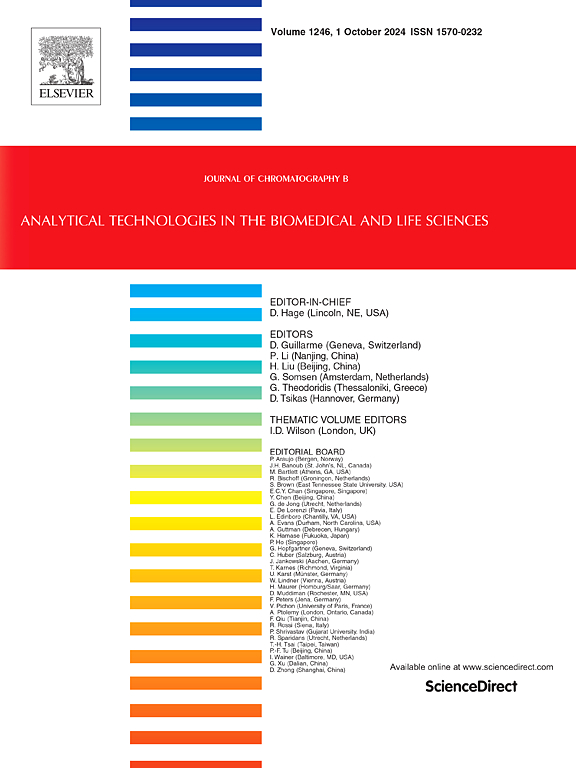Development and validation of an LC-MS/MS method for quantifying a new G protein selective μ-opioid receptor agonist YZJ-4729 and its major metabolite M10 in human plasma to support a phase I study in healthy subjects
IF 2.8
3区 医学
Q2 BIOCHEMICAL RESEARCH METHODS
引用次数: 0
Abstract
The use of conventional opioids that act on μ-receptors is a recognized care agent for moderate-to-severe acute treatment. However, recent attention has shifted to a new class of μ-receptor agonists which can selectively activate the G-protein pathway and thus have better efficacy and fewer side effects. Recently, YZJ-4729 was developed as a new G protein selective μ-opioid receptor agonist. And for its clinical trial investigation usage, a rapid LC-MS/MS method was established for the concurrent measurement of YZJ-4729 and its major metabolite M10 in human plasma. A step involving the precipitation of proteins was used for plasma sample preparation. The chromatography separation was done on a Poroshell 120 EC-C18 analytical column (2.1 × 50 mm, 2.7-μm, Agilent). Gradient elution was performed with 5.0 mM ammonium acetate (NH4Ac) and 0.1 % formic acid (FA) water solution as the mobile phase A and pure acetonitrile (ACN) as the mobile phase B. Detection occurred in the mode of positive ion electrospray ionization through multiple reaction monitoring using deuterium YZJ-4729 (d6-YZJ-4729) as the internal standard. The ionic transitions used were YZJ-4729: m/z 409.3 → 244.2; d6-YZJ-4729: m/z 415.3 → 244.2; M10: m/z 425.3 → 260.2;). The method showed excellent linearity across the ranges of 0.500 to 500 ng/mL for YZJ-4729 and 0.0500 to 50.0 ng/mL for M10. The method was utilized to assess the plasma concentrations of YZJ-4729 and M10 in healthy volunteers after a 30-min intravenous infusion in the phase I clinical study, and the clinical pharmacokinetic profiles of YZJ-4729 and M10 were described.
建立和验证一种LC-MS/MS方法定量新的G蛋白选择性μ-阿片受体激动剂YZJ-4729及其在人血浆中的主要代谢物M10,以支持健康受试者的I期研究
使用传统的阿片类药物作用于μ受体是公认的中重度急性治疗的护理剂。然而,近年来人们的注意力转向了一类新的μ受体激动剂,它们可以选择性地激活g蛋白通路,从而具有更好的疗效和更小的副作用。YZJ-4729是一种新型G蛋白选择性μ-阿片受体激动剂。针对YZJ-4729的临床研究用途,建立了同时测定人血浆中YZJ-4729及其主要代谢物M10的快速LC-MS/MS方法。血浆样品的制备采用了一个涉及蛋白质沉淀的步骤。色谱柱为Poroshell 120 EC-C18 (2.1 × 50 mm, 2.7-μm, Agilent)。以5.0 mM醋酸铵(NH4Ac)和0.1%甲酸(FA)水溶液为流动相A,纯乙腈(ACN)为流动相b,进行梯度洗脱。以YZJ-4729 (d6-YZJ-4729)氘为内标,采用正离子电喷雾电离方式进行多重反应监测。使用的离子跃迁为YZJ-4729: m/z 409.3→244.2;d6-YZJ-4729: m/z 415.3→244.2;M10: m/z 425.3→260.2;)。YZJ-4729在0.500 ~ 500 ng/mL和M10在0.0500 ~ 50.0 ng/mL范围内呈良好的线性关系。在I期临床研究中,采用该方法评估健康志愿者静脉输注YZJ-4729和M10的血药浓度,并描述YZJ-4729和M10的临床药代动力学特征。
本文章由计算机程序翻译,如有差异,请以英文原文为准。
求助全文
约1分钟内获得全文
求助全文
来源期刊

Journal of Chromatography B
医学-分析化学
CiteScore
5.60
自引率
3.30%
发文量
306
审稿时长
44 days
期刊介绍:
The Journal of Chromatography B publishes papers on developments in separation science relevant to biology and biomedical research including both fundamental advances and applications. Analytical techniques which may be considered include the various facets of chromatography, electrophoresis and related methods, affinity and immunoaffinity-based methodologies, hyphenated and other multi-dimensional techniques, and microanalytical approaches. The journal also considers articles reporting developments in sample preparation, detection techniques including mass spectrometry, and data handling and analysis.
Developments related to preparative separations for the isolation and purification of components of biological systems may be published, including chromatographic and electrophoretic methods, affinity separations, field flow fractionation and other preparative approaches.
Applications to the analysis of biological systems and samples will be considered when the analytical science contains a significant element of novelty, e.g. a new approach to the separation of a compound, novel combination of analytical techniques, or significantly improved analytical performance.
 求助内容:
求助内容: 应助结果提醒方式:
应助结果提醒方式:


